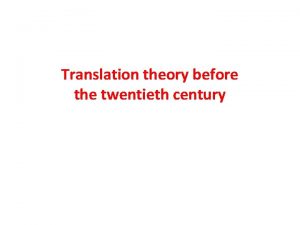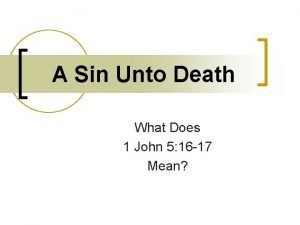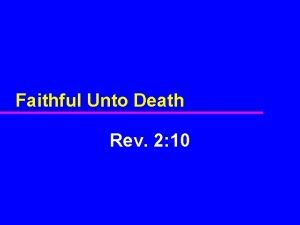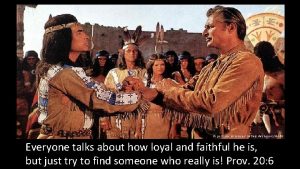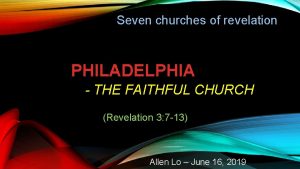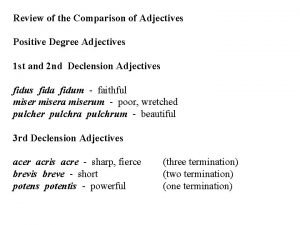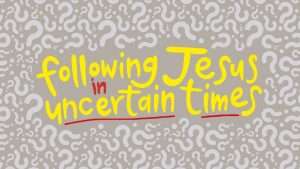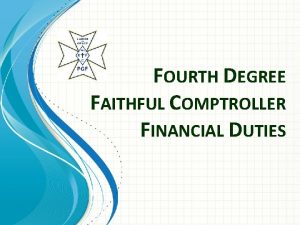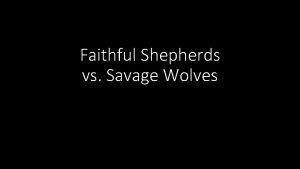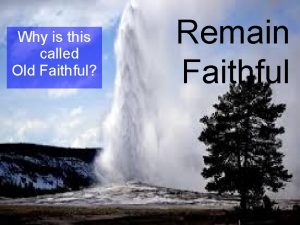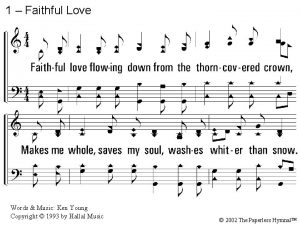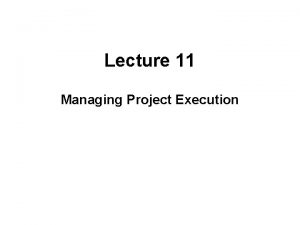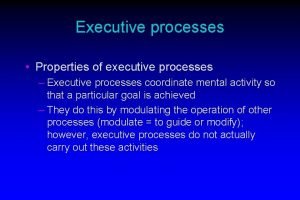Lecture 10 The Executive Part 2 Faithful Execution

















- Slides: 17

Lecture 10 The Executive Part 2: Faithful Execution of Powers And the Veto Power

This Lecture Topics Faithful execution of laws Veto Power Signing Statements It covers pages 199 -213

In re Neagle (1890) Background Justice Field sat out this case since he was involved Terry and Field went to California during the 1849 Gold Rush Both became California State Supreme Court Justices 1859 - a bitter feud between Terry and U. S. Sen. David Broderick Terry resigns his position and challenges Broderick to a duel and kills him Field was a field of Broderick and vowed to never forget Field became chief justice, and later was appointed to the U. S. Supreme Court

In re Neagle- II More lurid details Terry represented Sarah Hill, who claimed to be the wife of former Sen. William Sharon of Nevada, a millionaire She sued him for divorce based on adultery, but he denied being married to her Her document was ruled a forgery and it was ruled she was never married to him Field died and his son wanted to end Hill’s claim to his father’s estate Terry had married Hill The three judge panel had Field assigned as a judge The court ruled for Sharon’s son Sarah (now Terry) accused Field of bribery to reach the decision

In re Neagle- III Yet more lurid details Field ordered the U. S. Marshals to remove her Mr. Terry struck the marshal and pulled a knife Sarah Terry tried to pull a gun They got one month (Sarah) and six months (David) in jail for contempt Mr. Terry vowed to horsewhip and kill Field So President Harrison and the AG assigned a federal marshal (Neagle) to protect Field on his next trip to California as a judge The followed him on a train and in Lanthrop, while Sarah had went back to the train for the revolver, David slapped the judge and reached into his coat Neagle ordered him to stop and when he did not he shot and killed him

In re Neagle- IV What happens next Sarah claims Neagle murdered her husband Neagle was charged with murder and Field as an accomplice The charge on Field was dropped A federal court granted Neagle a writ of habeas corpus and he was released The State of California appealed Question: Did Neagle have the authority to act as he did in this case? Could the President issue an executive order for this protection?

In re Neagle- V Arguments For (by California) Neagle only was allowed to protect field in the Courthouse Neither the President or the AG had the power to authorize Neagle to protect field anywhere outside the Courthouse What is the source of the presidential authority to do this? (slippery slope argument) Against (by Neagle) The President is authorized to “take care that the laws are faithfully executed” This clause gives the President implied powers beyond expressly delegated ones, independent of congressional statutes The necessary clause extends to the President as well It is the duty of the executive to protect members of the judiciary Protection of judges is essential to the very existence of government

In re Neagle- VI Justice Miller rules for a 6 -2 Court Field does not participate No statute existed to send a marshal to protect him It is a duty of the executive for protection The Attorney General had acted correctly in assigning Neagle to Field so that laws could be faithfully executed This was necessary for the judicial branch to function without fear judges being shot Neagle gets the writ as well since federal law gives marshals the same power in executing laws as state sheriffs and their deputies Neagle can therefore not be prosecuted by California The dissent The say that if it cannot be traced to a piece of legislation passed by Congress, any power can therefore not exist

In re Debs (1894) President Cleveland sent in troops to prevent striking rail workers from obstructing the mail The Attorney General also got an injunction against the strikers Eugene Debs appeals, saying Cleveland had no such authority under the legislation Court ruled for Cleveland Every government has the right to apply to the court for proper assistance to assist the general welfare Youngstown Steel Seizure case Let’s save this for Chapter 5 to do it justice

Obligation to Enforce the Law The President is obliged to enforce all laws, not just the one he favors Some have openly refused to enforce certain laws Train v. City of New York (1975) President Nixon refuses to enforce provision of a Water Pollution Act passed over his veto The City of New York would have gotten grants, but Nixon refused to distribute them With no grant of discretion, the administration was required to enforce the law However, the administration does not have to defend laws in Court that it finds are unconstitutional Myers v. United States (1926) They can even argue against its constitutionality in Court U. S. v. Windsor (2013)

The Veto Power The Presentment Clause Article I, Section 7 Three choices Sign- It becomes law Veto- Override takes 2/3 vote of both chambers If he refuses to sign and the ten days are during adjournment, it is a pocket veto Nothing- It becomes law after ten days It is not common to override- 110 of more than 1500 The veto is all or nothing But some wanted the line-item veto Most governors have it Supporters said the President can strike out “pork barrel projects”

City of New York v. Clinton (1998) Raines v. Byrd (1997) Remember this one? Decided on the standing issue against Sen. Byrd had not suffered a loss Background These parties say they did suffer a loss due to the Line Item Veto Act The law allowed the President to cancel any dollar amount, new item of spending, or limited tax benefit Congress could pass a disapproval bill, subject to veto President Clinton vetoes provisions to give special tax breaks to Idaho potato farmers and for money for New York City hospitals

City of New York v. Clinton- II Question: Does this violate the Presentment Clause? Arguments For President Clinton All the parts of the Presentment Clause have been satisfied This occurs after those procedures President has discretion over spending Congress can specify certain bills not subject to cancellation For the City of New York The President must act as a whole to a bill Even though it occurs after, it tries to get around the Presentment Clause The lawmaking function belongs to Congress

City of New York v. Clinton- III Stevens rules for a 6 -3 Court Parties have harm, thus standing The President has in effect, amended two acts of Congress There is no provision for the President to enact, repeal, or amend statutes The Presentment clause is clear as to the President’s choices on a bill The return is of the whole bill, but cancellation is of part Washington understood it is all or nothing What the President signed is law, period This must be done by constitutional amendment, not statute (see Thornton)

City of New York v. Clinton- IV Scalia, J. concurring in part and dissenting in part Joined by O’Connor in whole and Breyer in part Should have used the term “declined to spend” This language “faking out” the Supreme Court Presentment Clause was complied with Breyer, J. dissenting Joined by O’Connor in full, and Scalia in part Does not violate separation of powers The Constitutional allows for “novel methods”

Signing Statements Signing statements Expresses the president’s interpretation of the language of the law Announces constitutional limits on the implementation on some the law’s provisions Indicates directions to the executive branch as to how to administer the law George W. Bush seemed to take this further He issued 161 to Obama’s 20 (as of publication) Is this the executive trying to be the arbiter of constitutional law interpretation? Most Bush challenges were to constitutionality- this is where he goes further

Next Lecture More on the Executive Branch Appointment Power Removal Power Pages 212 -237
 01:640:244 lecture notes - lecture 15: plat, idah, farad
01:640:244 lecture notes - lecture 15: plat, idah, farad Faithful translation example
Faithful translation example Sin unto death meaning
Sin unto death meaning He is a friend of mine the god of angel armies
He is a friend of mine the god of angel armies Prayer come holy spirit
Prayer come holy spirit Rev 2:10
Rev 2:10 Loyal vs faithful
Loyal vs faithful Were pilgrims on a journey of a narrow road
Were pilgrims on a journey of a narrow road Faithful in adversity
Faithful in adversity The faithful church in revelation
The faithful church in revelation O come all ye faithful public domain
O come all ye faithful public domain Comparative degree of faithful
Comparative degree of faithful Post turtle meme
Post turtle meme Your faithful servant
Your faithful servant If you confess your sin he is faithful
If you confess your sin he is faithful Be faithful unto death and i will give
Be faithful unto death and i will give Blessed with faithful abraham
Blessed with faithful abraham Abraham
Abraham

